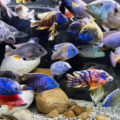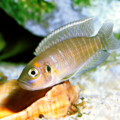A complete guide on the vibrant, colorful beauty of Pelvicachromis Pulcher, including special care tips on preserving its distinct colorful scales, internal health, and emotional state.

Does it surprise you to learn that Pelvicachromis pulcher, popularly known as Kribensis Cichlid, “Kribs”, is a peaceful and adaptable species. And If you want to learn about Pelvicachromis pulcher’s care and get the best colorful freshwater tips to ensure your pets stand out in any community tank, you’re in the right place.
See Also: The 39 Most Colorful Freshwater Aquarium Fish
This Kribensis Cichlid overview takes you through hardy waters as you learn identification tips, feeding plans, breeding techniques, and health care regimens for maintaining your Pelvicachromis pulcher’s vibrancy.
The Stunning Colors of Pelvicachromis Pulcher
Identifying the Pelvicachromis pulcher based on sex is easy because of its unique sexual dimorphism. Simply put, you can separate the males from the females using the Kribensis cichlid’s coloration and other physical features.
Color Pattern
These colorful dwarf cichlids are sometimes called rainbow kribs because of their multicolored scales, but here’s how to differentiate males from females based on their hues.
While both sexes have neutral base tones with deep brown highlights trailing from head-to-tail, there are slight differences explained in the table below.
See Also: 12 Types of Freshwater Rainbowfish: A Guide to Colorful Aquatic Gems
| Male Kribensis | Female Kribensis |
– Elongated/pointed dorsal and anal fins – Larger (Up to 3.5 – 4 inches), while females typically only grow to about 2.5 – 3 inches. | – Shorter, rounded anal fins. – Deeper red bellies during spawning than males which are a slightly duller red. |
Unique Traits
Mature Kribs have elongated oval bodies with tapered tails and rounded heads. Typically, females are about 3 inches long, making them rounder and smaller than their male counterparts, which can be up to 4 inches long as mentioned.
Other unique traits include their active swimming and territorial behavior during breeding.
Setting Up a Home for Pelvicachromis Pulcher
To create the perfect home for your pets, you must imitate the natural habitat of Kribensis Cichlids. This will help them grow naturally and have healthy interactions as they would in the wild. Let’s get straight to the tips for the best Pelvicachromis pulcher tank setups.
Tank Size and Layout
- Size: 20 gallons/duo, 30 gallons/quartet
- Layout: rectangular and spacious
Water Conditions
- Temperature: 75 – 82℉
- pH Level: Slightly acidic, 6.5-7.5
- Hardness: Soft – moderately hard, 4-12 dGH
Substrate and Decor

Building an aquarium setup for these peaceful fish’ existence requires a balance of substrate and decor. The substrate is the first layer at the tank’s base, while decor is your unique creative design touch.
| Substrate | Decor |
| – Fine Sand, Smooth Gravel to encourage digging and foraging. | – Driftwood and rocks to form caves as hiding spots and breeding grounds. – Live plants like Java Fern and Amazon Swords for added aesthetics and shelter. – Moderate LED lighting with day-to-night cycles. – Gentle filtration |
Feeding Your Kribensis Cichlid: A Balanced Diet
Your pets need a rich omnivorous fish diet for a healthy life. It’ll keep them physically, mentally, and internally fit, so follow this Kribensis cichlid feeding guide carefully.
Diet Suggestions

| Staples | Supplements | Vegetables |
| – High-quality pellets – Algae Wafers | – Bloodworms – Mosquito Larvae | – Blanched Spinach – Peas – Fiber |
For more on feeding your aquatic pets check out The Ultimate Guide to Fish Food: Pros and Cons & Best Choices!
Feeding Tips
Curating your Pelvicachromis pulcher’s diet is only one step in feeding your pets. You must also regulate the number of times and portions you feed them.
- Frequency: Once to twice daily
- Portion: Consumable in less than 3 minutes
Breeding Pelvicachromis pulcher: A Fascinating Process

When breeding Kribensis cichlids, you must choose an ideal pair, preferably two that are naturally bonded. Then, proceed to the breeding tank’s setup.
Breeding Setup
| Tank Size | 20 gallons/pair |
| Temperature and pH Level | 75 – 82℉, Slightly acidic |
| Diet | High protein with enough supplements |
| Breeding Spot | Caves, flat stones for spawning |
Use this setup as a Pelvicachromis pulcher spawning guide to ensure you get the healthiest and best-looking Kribs fry.
The female rainbow kribs lay up to 100 eggs, which the males then fertilize externally. The parents guard their young and provide oxygen by fanning them within the first 2-3 days before the eggs hatch.
After hatching, the fry will become free-swimming in 5-6 days.
Fry Care Tips
Feeding, housing, and protection are the basis of raising cichlid fry. Start with infusoria and finely crushed cichlid fry food. As they grow, separate the stronger fry from the weaker ones to prevent bullying and predation.
Once your pets are mature, healthy, and ready to join the main tank, quarantine them for a few days before including them to the community.
Tank Mates for Pelvicachromis Pulcher: Building Harmony
You need peaceful aquarium fish as tankmates for Pelvicachromis pulcher if you want a harmonious tank. Failure to do that will reduce your pet’s lifespan and overall wellbeing. So, here are some compatible species for Kribensis cichlids:
Compatible Species
Ensure they have the same environmental needs, sizes and temperaments.
- Tetras
- Rasboras
- corydoras
Avoided Species
Avoid aggressive or large fish that cause stress, as they’ll disrupt your tank’s balance.
Preventing Health Issues in Pelvicachromis pulcher
With this Kribensis cichlid care guide, you can be better equipped to reduce the chance nof illnesses, but sometimes, it’s not enough. Your pets may have genetic triggers or other environmental illness-causing factors. So here’s a way to prepare you for the inevitable.
Preventative Measures
If you’ve followed this guide, you’ve taken the first steps in preventing cichlid illnesses, but there’s more. I’ll show you the signs of common diseases like Fin Rot and stress, how to match each symptom to a cause, and the best treatment for each illness.
Signs of Illness
| Sign | Illness | Cause | Treatment |
| Faded Coloration, Frayed Fins | Fin Rot | Bacterial and Fungal infection | Antibacterial and Antifungal treatments Improve Water Quality |
| Erratic Swimming, Appetite loss | Dropsy | Bacterial infection or Organ failure | Quarantine and Antibiotics |
| White Spots, Scratching, Rapid Gill Movement | Ich | Parasites | Increase temperature to speed up the parasite’s life cycle and Use Ich meds |
Check out How to Treat Ich Outbreaks in Your Freshwater Fish for more information on Ich! And see Also, 3 Types of Tiny White Worms Found in a Freshwater Aquarium to identify and rid your aquarium of vermin.
I hope you’ve enjoyed reading this guide’s Pelvicachromis pulcher health tips because they will help increase your pet’s lifespan.
Lifespan of Pelvicachromis Pulcher: Tips for Longevity
You must first understand the factors affecting your Kribensis’ lifespan to know how to optimize them for longevity.
Lifespan Factors
- Water stability
- Tank maintenance
- Compatible tank mates
Now follow these Kribensis cichlid lifespan extending tips to give your pets the longest possible life in good health.
Care Tips for Longevity
Consistent observation and preventive care already discussed in this healthy Pelvicachromis pulcher guide will help your pets live up to 5-8 years. So, here’s a quick recap of long-term care for dwarf cichlids in case you scrolled too fast:
- Maintain the water quality
- Concentrate on a high-protein diet
- Keep the water conditions optimal
Conclusion
This complete Pelvicachromis pulcher care guide makes beginners feel like experienced aquarists, and the experts get validation for practices they’ve perfected over time.
These Kribensis cichlids tips for beginners are straightforward to follow, and if you missed a step, here’s a summary for you:
- Create an ideal tank setup
- Feed your pets a healthy, balanced diet
- Preserve its vibrant, colorful scales with healthy practices
- Ensure preventive methods for longevity.
Remember that mimicking the natural habitat is the best freshwater aquarium fish care you can give your pets. And this is where I leave you today.










